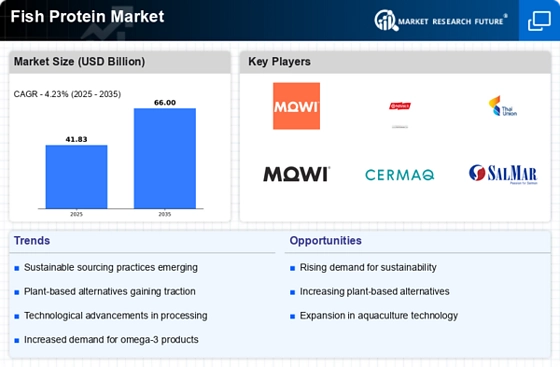Rising Demand for Protein Sources
The Fish Protein Market is experiencing a notable increase in demand for alternative protein sources. As consumers become more health-conscious, they are seeking high-quality protein options that are low in fat and rich in essential nutrients. Fish protein, being a complete protein source, is gaining traction among fitness enthusiasts and health-conscious individuals. According to recent data, the consumption of fish protein is projected to grow at a compound annual growth rate of approximately 5% over the next five years. This trend indicates a shift in dietary preferences, with fish protein being favored over traditional meat sources. The Fish Protein Market is thus positioned to benefit from this rising demand, as consumers increasingly prioritize health and nutrition in their food choices.
Growing Popularity of Plant-Based Diets
The rise of plant-based diets is influencing the Fish Protein Market in unexpected ways. While plant-based proteins are gaining popularity, many consumers are seeking to complement their diets with high-quality fish protein. This trend is particularly evident among flexitarians who aim to reduce meat consumption while still incorporating fish into their meals. The Fish Protein Market is likely to benefit from this hybrid dietary approach, as it offers a balance between plant and animal protein sources. Market data indicates that the demand for fish protein among flexitarians is on the rise, suggesting a potential growth avenue for producers. This trend may encourage innovation in product offerings, catering to the evolving preferences of health-conscious consumers.
Increased Focus on Nutritional Benefits
The nutritional profile of fish protein is becoming a focal point in the Fish Protein Market, as consumers seek foods that offer health benefits. Fish is known for its high omega-3 fatty acid content, which is associated with numerous health advantages, including heart health and cognitive function. As awareness of these benefits spreads, the demand for fish protein is likely to increase. Recent studies indicate that consumers are willing to pay a premium for fish products that highlight their nutritional advantages. This trend presents an opportunity for producers to market their fish protein products effectively, emphasizing health benefits and quality. The Fish Protein Market is thus poised for growth as consumers prioritize nutrition in their dietary choices.
Technological Advancements in Aquaculture
Technological innovations in aquaculture are transforming the Fish Protein Market, enhancing production efficiency and sustainability. Advances in breeding techniques, feed formulations, and disease management are enabling fish farmers to increase yields while minimizing environmental impact. For instance, the implementation of recirculating aquaculture systems (RAS) has shown promise in reducing water usage and improving fish health. As these technologies become more widespread, they are expected to bolster the supply of fish protein, meeting the growing consumer demand. The Fish Protein Market stands to gain from these advancements, as they not only improve production efficiency but also align with the increasing consumer preference for responsibly sourced products.
Sustainability and Environmental Awareness
Sustainability has become a pivotal concern for consumers, influencing their purchasing decisions in the Fish Protein Market. As awareness of overfishing and environmental degradation grows, consumers are gravitating towards sustainably sourced fish products. The market is witnessing a surge in demand for fish protein derived from aquaculture practices that adhere to environmental standards. Reports suggest that sustainably sourced fish protein could account for a significant portion of the market share by 2026. This shift not only reflects consumer preferences but also encourages producers to adopt sustainable practices, thereby enhancing the overall reputation of the Fish Protein Market. The emphasis on sustainability is likely to drive innovation and investment in eco-friendly production methods.

















Leave a Comment